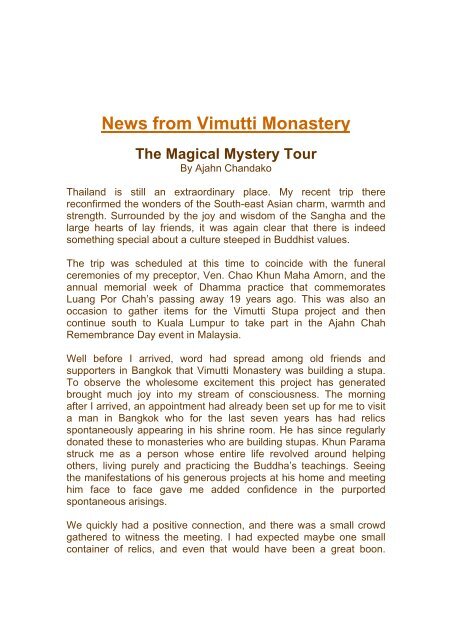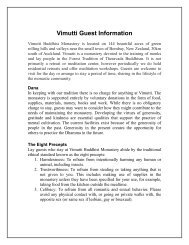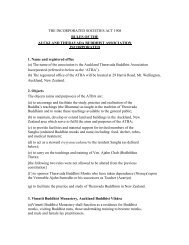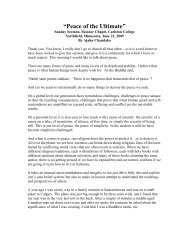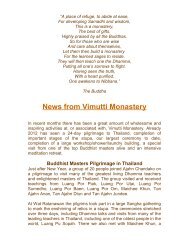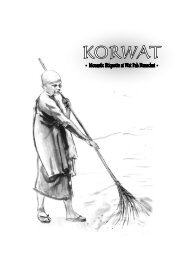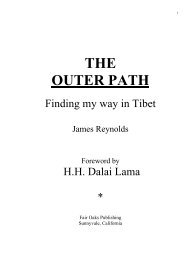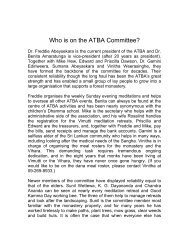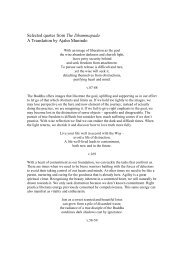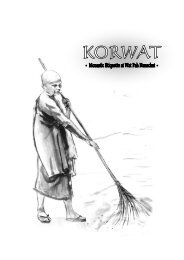11.2_newsletter_feb_.. - Vimutti Buddhist Monastery
11.2_newsletter_feb_.. - Vimutti Buddhist Monastery
11.2_newsletter_feb_.. - Vimutti Buddhist Monastery
Create successful ePaper yourself
Turn your PDF publications into a flip-book with our unique Google optimized e-Paper software.
News from <strong>Vimutti</strong> <strong>Monastery</strong><br />
The Magical Mystery Tour<br />
By Ajahn Chandako<br />
Thailand is still an extraordinary place. My recent trip there<br />
reconfirmed the wonders of the South-east Asian charm, warmth and<br />
strength. Surrounded by the joy and wisdom of the Sangha and the<br />
large hearts of lay friends, it was again clear that there is indeed<br />
something special about a culture steeped in <strong>Buddhist</strong> values.<br />
The trip was scheduled at this time to coincide with the funeral<br />
ceremonies of my preceptor, Ven. Chao Khun Maha Amorn, and the<br />
annual memorial week of Dhamma practice that commemorates<br />
Luang Por Chah’s passing away 19 years ago. This was also an<br />
occasion to gather items for the <strong>Vimutti</strong> Stupa project and then<br />
continue south to Kuala Lumpur to take part in the Ajahn Chah<br />
Remembrance Day event in Malaysia.<br />
Well before I arrived, word had spread among old friends and<br />
supporters in Bangkok that <strong>Vimutti</strong> <strong>Monastery</strong> was building a stupa.<br />
To observe the wholesome excitement this project has generated<br />
brought much joy into my stream of consciousness. The morning<br />
after I arrived, an appointment had already been set up for me to visit<br />
a man in Bangkok who for the last seven years has had relics<br />
spontaneously appearing in his shrine room. He has since regularly<br />
donated these to monasteries who are building stupas. Khun Parama<br />
struck me as a person whose entire life revolved around helping<br />
others, living purely and practicing the Buddha’s teachings. Seeing<br />
the manifestations of his generous projects at his home and meeting<br />
him face to face gave me added confidence in the purported<br />
spontaneous arisings.<br />
We quickly had a positive connection, and there was a small crowd<br />
gathered to witness the meeting. I had expected maybe one small<br />
container of relics, and even that would have been a great boon.
However, I wasn’t prepared for the quantity and variety of the relics<br />
he was about to bestow on our monastery. In fact, the longer I was<br />
there, the more relics, ancient Buddha statues and other psychically<br />
charged items he produced as gifts. The relics themselves had been<br />
regularly manifesting in front of his shrine, and he would then<br />
meticulously sort through them and store them with respect. I asked<br />
how he knew what relics were what, and he said the answers come<br />
to him when he meditates.<br />
At this point I might want to pause for the uninitiated—those openminded<br />
but rational people with a realistically mature sense of<br />
sceptical doubt. “You’re not actually saying that they just appeared<br />
out of thin air, are you?” Well,…..<br />
When living in Thailand there are certain things that are encountered<br />
where it is simply practical to suspend the urge to analytically<br />
comprehend something that seems to challenge rational<br />
explanation—and in that society this can often be the best approach.<br />
Don’t think too much. But try getting away with that in a non-Asian<br />
context. People generally expect a bit more flesh of explanation on<br />
the bones.<br />
OK, here goes. The whole reason we at <strong>Vimutti</strong> and the ATBA are<br />
undertaking this massive project of building a stupa is to house relics.<br />
But what the heck are they?<br />
Relics are small, opaque, gem-like or granular substances that are<br />
purported to come from the bodies of the Buddha or his highly<br />
attained disciples.<br />
“So you’re trying to tell me that you actually have lots of real bits of<br />
Buddha bone that have come flying out of the cosmos?” No, of<br />
course not, silly. Bone is bone. But relics are relics.<br />
Interesting things sometime happen in meditation. Because at a<br />
fundamental level, the difference between physical matter and mental<br />
energy becomes blurred or disappears altogether, when a person has<br />
mastered a great degree of control over their mind, he or she is<br />
correspondingly able to manifest a type of control over the physical<br />
realm that is normally referred to as a ‘miracle’. This psychic power
can be exercised in various ways. People who have these abilities<br />
are quite rare in modern times, but they do still exist. Those who are<br />
true masters, however, almost never display these powers in public.<br />
For people whose consciousness has been purified of greed, anger,<br />
lust and selfishness, that pure mental energy is constantly interacting<br />
with the physical matter of their bodies. When they die and their<br />
bodies are cremated on a wood fire, small bone fragments always<br />
remain. For average people these bones remain as bones. For highly<br />
developed people it is possible that their bones then gradually turn<br />
into hard substances of various colours that are known as relics. This<br />
can happen especially if, while they were still alive, they had<br />
determined it to happen. This phenomenon of transformation has<br />
been well documented in modern times as the Arahant disciples of<br />
Ajahn Mun gradually passed away in the 20 th and 21 st century. The<br />
relics of these masters are usually enshrined in glass viewing cases<br />
inside stupas dedicated to their lives.<br />
However, there is not a one-to-one correspondence between<br />
enlightenment and relics. Some people with exceptionally refined<br />
Samadhi, but who have not yet realised the stages of enlightenment,<br />
have minds that are pure enough that their bones can turn into relics.<br />
And it also seems to be the case that not all truly enlightened<br />
masters’ bones do turn into relics. So it’s not a sure thing.<br />
OK, so you might be able to bend your mind around the possibility of<br />
bone fragments physically transforming, but get this…then the relics<br />
multiply.<br />
“Oh come on.”<br />
Don’t ask me to explain how it happens. But you have loads of<br />
Buddha relics and only so many verifiable Buddha bones to begin<br />
with, so what’s the deal? They multiply on their own. No, they are not<br />
breeding, but stories of relics multiplying are heard so often that it<br />
becomes difficult to dismiss it all as the exaggerated tales of the<br />
overly faithful. It seems that if relics are treated with respect and the<br />
owner keeps good sila, it is possible that they will multiply. It’s also<br />
possible that they will disappear if behaviour is not up to standard,<br />
and this can be quite embarrassing.
Honestly, I’m a sceptic by nature, but one of the most convincing<br />
stories I’ve heard is when Ven. Ajahn Pasanno, the Canadian abbot<br />
of Abhayagiri <strong>Monastery</strong>, gave some relics to his mother. He offered<br />
her a small number of them in a tiny clear container during the time<br />
his father was dying and instructed her on how to look after them<br />
properly. His mother is very down to earth and not <strong>Buddhist</strong>, but she<br />
did as he suggested. At a later time when speaking with her son she<br />
asked, “What’s with these little things you gave me? There’s a lot<br />
more of them now than there used to be.” That’s just what happens.<br />
Look, I just try to keep an open mind. During my time in Thailand, my<br />
perception of what is possible was stretched far beyond its previous<br />
limits. Once you accept the possibility of inert physical matter<br />
multiplying on its own, it is not a far leap to contemplate them<br />
appearing spontaneously out of the blue. Apparently there is a bit of a<br />
science to it: certain chants and determinations can be done and a<br />
clean white piece of cloth can be laid out before the shrine or in front<br />
of you when you meditate to increase the possibility of it happening.<br />
Another explanation is that unseen beings from heavenly realms<br />
(devas) bring relics as gifts to those who they feel deserve them.<br />
I would imagine that not all relics are the real McCoy. There are<br />
bound to be some fakes—either intentional or innocently mistaken.<br />
To know for sure what is what, you would have to have them checked<br />
by a highly attained meditation master with specific psychic gifts.<br />
Such a person can actually ‘see’ the energy being emitted from the<br />
substance and determine its origin. In the meantime, however, I<br />
figured it was prudent to error on the side of respect. Better to show<br />
reverence to all the relics offered, assuming that some were real,<br />
than to make the bad kamma of showing disrespect towards what is<br />
possibly very special. In the end, bringing up a mental state of<br />
respect and reverence is always good kamma. In the same way that<br />
we bow to a bronze or stone Buddha statue as a symbol of the<br />
Awakened mind that we aspire to, relics at the very least serve to<br />
focus our devotional energy and remind us of a higher purpose in life.<br />
They can motivate us to follow in the Buddha’s footsteps.<br />
The wisdom perspective is to take the standard that all external<br />
phenomena are not necessarily as they appear to be. None of it is
eliable enough for basing our long term happiness on. So from this<br />
perspective you can take the relics with a grain of salt, or a grain of<br />
sand as the case may be, and know that a belief in them is not<br />
essential for walking the path to enlightenment. In the end, nothing in<br />
conditioned reality is a sure thing. Our only reliable refuge is within.<br />
Anyway, during the time we were visiting Khun Parama’s home, I<br />
certainly wasn’t about to indulge the western-trained judgemental<br />
mind. In many ways I am just a fortunate messenger, an impartial<br />
vehicle for encouraging goodness, joy and inspiration and<br />
transporting the opportunity for making wholesome kamma from<br />
country to country. From what I have observed, relics and stupas<br />
certainly tend to bring out pure-hearted qualities in people, and really,<br />
that’s good enough for me.<br />
So that was the first day.<br />
The next day was also stupa-oriented but of a decidedly more earthly<br />
nature. Khun Nacha and Somkiet, Auckland residents and <strong>Vimutti</strong><br />
supporters, took me to an area near the town of Chonburi to research<br />
stone sculptors and appropriate stone for carving Buddhas for the<br />
stupa. They and their family plan to sponsor four of the nine Buddha<br />
statues associated with our stupa. Four will go inside, four outside<br />
and one will be housed in an adjoining shrine. The four statues to be<br />
placed within the stupa have been ordered from Indonesia, to be<br />
carved from the same stone as the famous Borobudur stupa nearby.<br />
The following day was full of connecting and reconnecting with new<br />
and old friends at the Sangha residence in Bangkok known as<br />
Dhammaram. For monks living in remote South Sea Islands, this<br />
Dhamma bonding is particularly nourishing. Ven. Ajahn Chandapalo,<br />
abbot of the Italian branch monastery, and Ven. Ajahn<br />
Nyanadhammo, abbot of Ratanawan monastery in Thailand and<br />
former abbot of Wat Pah Nanachat, both arrived. There were also<br />
many joyful meetings with lay friends whom I have known for years.<br />
The next day I met with the head of the World Tipitaka Project, a<br />
massively meticulous, decade-long undertaking to produce the<br />
optimal version of the Pali Cannon in Roman script. We are hoping to<br />
enshrine this version inside the <strong>Vimutti</strong> Stupa. Nacha, Somkiet, other
friends and I then went to research sculptors in a different area near<br />
Pak Chong. On the way we visited Ven. Ajahn Jayasaro, also a<br />
former abbot of Wat Pah Nanachat. It was refreshing to have the<br />
opportunity to discuss meaningful matters with Sangha elders on a<br />
daily basis. Ajahn Jayasaro had just returned from Burma where he<br />
had been given relics of Sariputta and Moggallana. These he then<br />
offered for the <strong>Vimutti</strong> Stupa.<br />
On the 11 th of January we were joined by Ven. Ajahn Amaro, the new<br />
abbot of Amaravati <strong>Monastery</strong> in England. Nacha and Somkiet then<br />
took me to visit Luang Por Piek, one of the most eminent of all the<br />
Luang Por Chah disciples. I had spent my first rains retreat as a<br />
monk with Luang Por Piek, so I have always felt a special sense of<br />
gratitude towards him. Furthermore, he is one of the most<br />
accomplished meditation masters alive in the world today—no<br />
exaggeration. He could tell you what relics were real and what were<br />
not. The main reason I went was to invite him to <strong>Vimutti</strong>. He said he<br />
was free. Nacha immediately spoke up to sponsor the plane ticket.<br />
Sadhu. We are currently trying to arrange a visit and Easter retreat in<br />
the second half of April. While Luang Por Piek and I were talking in<br />
private I tried to get some inside info on how relics spontaneously<br />
appear. ‘Come on, you can tell me, Ajahn, wink, wink, that sort of<br />
thing’. But he wouldn’t get any more specific than saying that they<br />
come from the atmosphere. He did speak about how some people<br />
have kammic connections with relics that carry on from life to life,<br />
based on similar determinations as Bodhisatta vows to become a<br />
Buddha.<br />
From there we went straight to the airport and due to Bangkok traffic I<br />
nearly missed my flight to Ubon, the spiritual home of the Ajahn Chah<br />
tradition. A vanload of monks from Wat Pah Nanachat was waiting to<br />
greet us—including the new abbot, Ajahn Kevali—and Ajahns Amaro,<br />
Vajiro, Chandapalo and I were all whisked off to Wat Pah Vivek, the<br />
monastery where I ordained.<br />
Between the time that Luang Por Chah fell ill and Luang Por Liem<br />
became a preceptor, everyone who wanted to be a monk at Wat Pah<br />
Nanachat was taken to ordain at this monastery of Chao Khun Maha<br />
Amorn. Ven. Chao Khun was a long standing disciple of Luang Por<br />
Chah, and he passed away in late November of 2010. This evening’s
funeral ceremonies were being held to mark the 50 th day since his<br />
passing, but the actual cremation would take place a year later. In<br />
typical rural North-east Thai style, it was hardly a sombre occasion.<br />
Half full-on Dhamma practice and half class reunion, the evening was<br />
marked by Dhamma talks and meditation throughout the night<br />
interspersed with joyous catching up with friends that had not been<br />
seen in years.<br />
Luang Por Sumedho was there: radiant, relaxed and solid. Hundreds<br />
of Thai monastic disciples of Ajahn Chah were there. As the<br />
melodious roar of the evening chanting reverberated throughout the<br />
hall, I felt a deep appreciation for being in the midst of this extended<br />
spiritual family. The inlaid casket of Ven. Chao Khun presided over<br />
the dusk-til-dawn proceedings from an appropriately high vantage<br />
point off to one side. For me it was meaningful to be back at the place<br />
where my monk’s life officially began. Memories of the samanera and<br />
bhikkhu ordinations were still clear. The gratitude towards the elders<br />
who made this life possible for me began to well up.<br />
The next morning, as Luang Por Sumedho sat cross-legged on a<br />
bench in a nearby kuti, sipping coffee surrounded by the Western<br />
Elders, I asked him about the significance of a mural in Ven. Chao<br />
Khun’s ordination hall. There, Luang Por Chah was depicted flanked<br />
by a young Ajahn Amorn and an equally youthful Ajahn Sumedho.<br />
Luang Por Sumedho recounted that the two of them were both there<br />
in the early days of Wat Pah Pong, Ajahn Chah’s monastery. Ajahn<br />
Amorn had been the first well educated disciple of Ajahn Chah. Even<br />
when Ajahn Amorn was only in his 30’s he was already an important<br />
figure in the Sangha hierarchy in the Ubon region. Because of his<br />
competence, it seemed clear that he was destined to rise to positions<br />
of great status and rank. Then he met Ajahn Chah. That changed<br />
everything. Ajahn Chah didn’t live at all like the monks in the<br />
mainstream. His only priority was practicing for liberation and helping<br />
others. After some serious consideration, Ajahn Amorn then made<br />
the radical decision to give up all of his status, money, power and<br />
expected future to live the humble life of a forest monk. That was<br />
quite a renunciation at the time, nearly unheard of.<br />
We then returned to the meditation hall for a rousing pre-meal<br />
Dhamma talk by Luang Por Liem, the current head of the Luang Por
Chah tradition. After the meal we drove to Wat Pah Nanachat to<br />
settle in. The International Forest <strong>Monastery</strong> now has an impressive<br />
new main hall. It was the brain child of Luang Por Liem himself.<br />
Beginning with the demolition of the old hall, Luang Por Liem was on<br />
site directing and fully participating in every step of the building<br />
process from start to finish. All the work was done by Thai and foreign<br />
monks. Rain or shine, Luang Por Liem was there working hard,<br />
climbing the tall scaffolding and supervising each detail of the<br />
construction.<br />
The next day was filled with informal meetings with senior monks,<br />
and seeing some of the local Thai lay people whom I’d been to India<br />
with on pilgrimage. In the afternoon we all went over to Wat Pah<br />
Pong to take part in the memorial event there. Even though it has<br />
been 19 years since Luang Por Chah passed away, the week of<br />
practice commemorating his life and death draws more people than<br />
ever. Nearly 1000 monks came to take part, many living in the forest<br />
under their brown mosquito net umbrellas. Many 1000’s of lay<br />
disciples also came to stay in the forest, pitching tents or hanging<br />
their own white mosquito net umbrellas. Each day there were<br />
numerous Dhamma talks from senior teachers, morning and evening<br />
chanting and meditation throughout the day. Many other people come<br />
to lend their support by giving away free food and drinks. Dozens of<br />
home-made stalls had suddenly sprung up near the entrance of the<br />
monastery with the sole purpose of offering bodily nourishment to<br />
those who were there to nourish their minds. Generosity and serving<br />
others is also Dhamma practice, so the amount of pure-hearted joy<br />
that was generated by all these thousands of people making good<br />
kamma was enormous.<br />
On January 14 we had a full day of Sangha meetings for the abbots<br />
of the overseas branch monasteries. Nearly all the abbots were there<br />
at Wat Pah Nanachat, so it seemed a good opportunity to discuss<br />
some weightly issues. Meetings can sometimes be tedious, and the<br />
ten hours of them planned for the day could potentially have been<br />
excruciating. However, I found them to be anything but. Throughout<br />
the day I was repeatedly impressed with the level of skill, honesty and<br />
sensitivity with which the elders spoke. They seemed to be one of the<br />
wisest, most knowledgeable and mature group of Dhamma teachers<br />
to be found anywhere on the planet. As the Buddha recommended:
meeting in harmony, discussing matters openly and parting in<br />
harmony conduces to the long life of the Sangha.<br />
I took the opportunity to offer relics to most of the senior Western<br />
monks for their monasteries. It was good to share the wealth of what<br />
Khun Parama had offered, and full sets of relics went to Ajahns<br />
Khemadhammo, Pasanno, Amaro and Chandapalo.<br />
The culmination of Luang Por Chah’s memorial event is the<br />
circumambulation of his stupa. However, organising a<br />
circumambulation is no simple affair when you have 20-30 thousand<br />
people who all want to come. The Sangha gathered at the main hall<br />
for chanting and then slowly made our way out the front door. The<br />
broad central road led to tables where innumerable sets of lotus<br />
flowers, candles and incense were waiting for us. Clasping the<br />
devotional offerings with hands held together at the chest, we silently<br />
proceeded down the long, wide avenues of the monastery. The river<br />
of brown robes was joined by a river of white clad devotees, all<br />
flowing with the same quiet power as a Ganges, Mississippi or Nile. It<br />
took nearly an hour before we ascended the steps of the stupa, laid<br />
our flowers, candles and incense at the foot of Luang Por Chah’s<br />
shrine, bowed three times and departed. If I had died then and there,<br />
I don’t think I would have minded.<br />
But I didn’t die. Actually I was taken to the airport instead. There, a<br />
local elderly woman came to see me off before I returned to Bangkok.<br />
She was one of the people on my first pilgrimage to India as a monk.<br />
On the 14 th she had brought relics and a box of other Buddha images<br />
to offer for <strong>Vimutti</strong> Stupa, but as I was engaged in meetings all day,<br />
she had to leave them without seeing me. I got the box out and asked<br />
her to explain the background of the various items. As she took out<br />
the amulets, she exclaimed in shock that relics had appeared<br />
embedded in some of them. She swore they hadn’t been there when<br />
she offered them a few days before. Who knows? All is uncertain.<br />
Arriving in Bangkok I was taken to a kuti dwelling next to Tau See<br />
<strong>Buddhist</strong> School. This school was started from scratch more than a<br />
decade ago by a pair of sisters and their family. Since then, and<br />
especially under the regular guidance of Ajahn Jayasaro, it has grown
to be a model of high quality, creative and modern <strong>Buddhist</strong><br />
education.<br />
It was a joy to see their family and friends again. In the morning one<br />
woman offered three relics, one of which she said had recently<br />
changed colour while at the ancient capital of Ayutthaya. I then left to<br />
visit Ven. Ajahn Anan, another of the current great meditation<br />
masters of Thailand. It was a three-hour drive, and on the way we<br />
visited Nacha’s aunt who had been eagerly waiting to offer us (you<br />
guessed it) relics—a large collection that she had been gathering for<br />
years. She and her mother had come to stay at <strong>Vimutti</strong> a few years<br />
earlier, and were so excited that they also offered Buddha statues<br />
and other supplies for the monastery.<br />
We arrived at Ven. Ajahn Anan’s monastery mid-afternoon. I had<br />
written to him about our stupa project, and he’d promised he would<br />
prepare something special for it. With great compassion, he proffered<br />
Buddha relics that had spontaneously appeared to him, Luang Por<br />
Chah relics, more relics, a box of psychically charged Buddha<br />
images, amulets, and power objects, Bodhi leaves from the Bodhi<br />
Tree at Bodh Gaya, and a good handful of his own hair. We had a<br />
chat, and he told us the story of when he was climbing Adam’s peak<br />
in Sri Lanka. In his shoulder bag he had an empty relic container.<br />
During the climb there were visible flurries of unusual and bright,<br />
glowing lights, and when Ajahn Anan later checked his bag he found<br />
that the container was now full of relics.<br />
On the way back to Bangkok we visited the couple who had<br />
sponsored the casting of the large bronze Buddha statue at <strong>Vimutti</strong>,<br />
They offered more items for the stupa.<br />
However, it wasn’t until the final day in Thailand that things really got<br />
rolling for the stupa. I mean we’re talking stupandous. In the morning<br />
and afternoon we went in search of and subsequently found relic<br />
containers that were suitably distinguished for this increasingly<br />
impressive collection that was amassing. Upon return to the kuti, a<br />
group of long-standing Dhamma practitioners, supporters and friends<br />
awaited my return. One offered Buddha relics and 2,000 small<br />
Buddha images for the stupa. Another offered Buddha relics, Buddha<br />
images, books on relics and much more. Another offered Buddha
images and a new set of robes. By this time it was evening, and I<br />
went to visit Dhammaram where the other senior monks were<br />
staying. When I arrived, one of our Sangha’s main supporters offered<br />
her relics for the stupa. Another friend offered Buddha images,<br />
reliquaries and other items for the stupa. I was then whisked off to<br />
visit another elderly Bangkok man who was well known for his relic<br />
and ancient Buddha collections. After finally finding his home through<br />
the dark maze of Bangkok’s back streets, we were entertained with<br />
stories before being offered a small stupa of Buddha relics. When we<br />
returned to Dhammaram (now getting late), I went to pay respect to<br />
Luang Por Sumedho. After a brief chat, he said, “I’ve got some<br />
Arahant relics from a collapsed stupa in Burma that I can give you.”<br />
By the time I got back to the kuti at the school, it was 11pm. I was<br />
leaving the next day on an early morning flight, and now had a small<br />
mountain of relics, holy objects, Buddha images, reliquaries and<br />
offerings for the monastery that I needed to sort, record, label and<br />
carefully pack that night. By 2:30 am, after hours of meticulous work,<br />
the numerous bags and boxes were packed, tied, readied and stored.<br />
After a few hour’s power sleep it was time to hit the air. In the predawn<br />
darkness one of the two Dhamma school sisters came to see<br />
me off, and in the perfect culmination of an extraordinary day, she<br />
said she had some Buddha relics to offer. All of the relics from the<br />
previous day had come from very reliable sources, but the ones she<br />
wished to offer had been in her royal family lineage for a long time,<br />
and were thus very special.<br />
My carry-on bag was absolutely stuffed chockablock with relics,<br />
amulets, power objects and Buddha images. I knew this plane ain’t<br />
gonna crash.<br />
I arrived in Kuala Lumpur for the second annual Ajahn Chah<br />
Remembrance Day. This was a full day of Dhamma teachings from<br />
various teachers of the Ajahn Chah lineage. In the days leading up to<br />
and following the event, we had an opportunity to visit various<br />
<strong>Buddhist</strong> centres in the city.<br />
Buddhism in Malaysia is experiencing an inspiring revitalisation.<br />
Although a <strong>Buddhist</strong> minority has long existed in this officially Muslim<br />
country, their traditional practices had lost most of what we normally
consider to be ‘<strong>Buddhist</strong>’. However, in the last decade, inspired by the<br />
forest tradition in Thailand and Burma, there has been a great<br />
blooming of interest in ‘real’ Buddhism. The sincerity, enthusiasm,<br />
devotion, knowledge and dedication to practice shown by these<br />
people made a deep impression on me. A couple of the new<br />
meditation centres that have sprung up are testaments to their strong<br />
spirit and competence. Enthusiastic to develop their dana parami (the<br />
perfection of generosity) as well, people made donations for our<br />
stupa and offered to send us the Tipitaka books in English that we<br />
needed to complete our set. On the final day, the organiser of the<br />
main event offered Buddha relics for the <strong>Vimutti</strong> Stupa.<br />
Relic Display<br />
and<br />
Ceremony to Honour the Physical Manifestations<br />
of Awakened Consciousness<br />
at<br />
<strong>Vimutti</strong> <strong>Buddhist</strong> <strong>Monastery</strong><br />
750 Paparata Road<br />
Bombay, South Auckland<br />
Saturday and Sunday February 19 & 20<br />
The full moon of February, Magha Puja, will serve as the occasion for<br />
a formal public exhibition of the <strong>Vimutti</strong> relic collection. We have<br />
extended the display and ceremonies another day to allow for greater<br />
numbers of people to attend.<br />
Please join us for this exceptional display of relics of the Buddha,<br />
many of his direct disciples and other meditation masters. This is one<br />
the most extensive collections ever seen outside of Asia. Gathered<br />
over many years from reliable sources, these relics are destined to be<br />
enshrined in the <strong>Vimutti</strong> stupa. The days will be complete with<br />
explanation and discussion of what relics are, how they are formed<br />
and their benefits.<br />
The display will be held at this time to celebrate Magha Puja, a major<br />
<strong>Buddhist</strong> holiday that commemorates the spontaneous assembly of
1,250 Arahants in the Buddha’s presence. On that occasion, the<br />
Buddha delivered the Ovada Patimokkha Gatha, a succinct teaching<br />
summarising the main points of the Dhamma. Please join us for this<br />
auspicious gathering, either Saturday, Sunday or both days.<br />
Schedule for both Saturday and Sunday:<br />
9:00 General viewing<br />
10:30 Meal preparations<br />
11:00 Shared meal (lay guests are requested to bring a plate of food<br />
to share)<br />
12:30 Paritta chanting and chanting from other traditions<br />
1:15 Explanation of relics by Sangha members<br />
Ovada Patimokkha Gatha explained<br />
Signing of the sacred central pole for the stupa<br />
2:15 Meditation in the presence of the relics<br />
3:00 Saturday: General viewing<br />
Sunday: Enshrining personal items for the <strong>Vimutti</strong> Stupa<br />
Everyone is invited to bring an item of personal significance to be<br />
enshrined in the stupa.<br />
Sangha members should bring their almsbowls, and if they would like<br />
to stay Saturday night, please contact vimutti.atba@gmail.com<br />
Ceremony for Enshrining Personal Items<br />
Sunday 3:00 pm, February 20<br />
On Sunday afternoon we will hold a ceremonial celebration to<br />
enshrine the personal items that people have offered for the stupa.<br />
These will then be sealed in a solid, waterproof and airtight container<br />
before being placed in the base, directly underneath the stupa. The<br />
box will then be surrounded by concrete slabs to ensure durability.<br />
Personal Items<br />
People are still welcome to bring items for the stupa up until the<br />
ceremony on February 20. So far we have received a wonderful array<br />
of items and personal messages. Thinking about what to include has<br />
been an opportunity for people to contemplate their lives, their loved<br />
ones and what is truly meaningful to them. We have received many
touching bits of people's lives, alive with much history and<br />
sentimental value.<br />
It is an extremely rare opportunity to be able to enshrine something<br />
personal in a stupa. The intention to include an object that has<br />
special relevance and meaning makes a kammic connection between<br />
your stream of consciousness and the relics. If it is done with the<br />
proper intention and devotional motivation, it will reduce the number<br />
and severity of any obstacles to practicing the Dhamma and increase<br />
the likelihood of you coming in contact with the teachings of the<br />
Buddha in future lifetimes. When you visit and circumambulate the<br />
completed stupa you will know that part of your life is enshrined there<br />
as well.<br />
It is best if the items are not larger than a rugby ball. For example:<br />
photos, jewelry, artifacts, stone carvings, items which have a powerful<br />
symbolic value, special stones, common everyday items that reflect<br />
your life, things made of glass, earth from sacred sites, crystals,<br />
gems, greenstone, or cards written with your individual aspirations or<br />
hopes for our planet. Another recommended item is Kiwiana: symbols<br />
and souvenirs of New Zealand… koru art, glass kiwi coasters, a<br />
carved kiwi bird, a rugby ball, a sheep doll, etc.<br />
You can bring items to <strong>Vimutti</strong> <strong>Monastery</strong> or to the Auckland <strong>Buddhist</strong><br />
Vihara, and the Sangha will look after them until the ceremony of<br />
placing them inside the base.<br />
Hierarchy of the items to be enshrined within the stupa<br />
The items enshrined will be ordered with a clear reverence for height<br />
and level of significance. The relics themselves will be placed in the<br />
square section, known as the harmika, near the top of the stupa.<br />
Directly below them, in the bell shaped section known as the anda,<br />
will be the Pali canon, the Tipitaka. In this area there will also be four<br />
large Buddha statues, numerous smaller ones, and many sacred<br />
objects and items of psychic potency. All these would still be above<br />
the waist level of the people circumambulating. In the square base,<br />
below foot level, but directly underneath the stupa, would be the box<br />
containing personal items. In this way, no one would actually be<br />
circumambulating the personal items, but they would be respectfully
tucked into a protected space below the level where people are<br />
worshipping or paying respect.<br />
Ceremony for Enshrining the Tipitaka and Buddha Images<br />
Saturday May 21, 2011<br />
Just after the full moon of May, Wesak or Visakha Puja, we will have<br />
the ceremony for enshrining the Tipitaka in the Stupa. These are the<br />
teachings of the Buddha that have been preserved in the Pali Canon,<br />
the oldest and most historically reliable account of what the Buddha<br />
taught. Both Pali and English versions will be included. On that day<br />
we will also be enshrining Buddha statues, the sacred central pole,<br />
holy amulets, and other sacred scripts.<br />
For complete details, background and architectural sketches,<br />
please see<br />
The <strong>Vimutti</strong> Stupa<br />
Other Developments<br />
At this time we are also currently building a garage and planning to<br />
upgrade our water collection system. In this way we plan to be able to<br />
store enough water to comfortably provide for future retreats.<br />
Venerable Ajahn Maha Boowa Passes Away<br />
It feels like the end of an era as the last major disciple of Ajahn Mun<br />
passed away on January 31 at age 97. ‘Old Grandad’ Maha Boowa<br />
as he was known, has been a pillar of Thailand. First he practiced<br />
with great determination as a disciple of Ajahn Mun and realized the<br />
stages of liberation. Then he became one of the foremost teachers<br />
and monastic trainers of his generation. Many of his books have been<br />
translated into English. Most of the donations given to him were used<br />
to build hospitals and schools. Then in his late eighties he decided to<br />
launch a nation-wide program to collect gold for the public treasury to<br />
save Thailand from economic difficulties. Traveling and teaching<br />
nearly constantly for the next few years, he collected 12 tonnes of<br />
gold and $10 million in cash that he then offered as reserves to the<br />
bank of Thailand.
Upcoming Meditation Retreats<br />
Day of Peace<br />
Saturday, February 26, 8:30am--4:00pm<br />
Led by Ajahn Chandako and Ven. Chang Shean<br />
This is a valuable opportunity for beginners and experienced<br />
meditators alike. This full day of meditation, instruction and silence is<br />
an excellent way to keep up with your dedication to inner peace.<br />
Meditation is a vital skill for developing calm and insight on the path<br />
to enlightenment. It has also been shown to reduce stress, strengthen<br />
the immune system and keep the left prefrontal cortex from<br />
deteriorating with age. It is a practical way to recharge your batteries<br />
and to train mindful awareness for integration into daily life. It is good<br />
to bring loose fitting clothing, a sun hat and some food for a shared<br />
lunch. Ven. Chang Shean is a Taiwanese bhikkhuni who leads the<br />
group in Chi Kung.<br />
Held at: <strong>Vimutti</strong> <strong>Buddhist</strong> <strong>Monastery</strong>, Bombay<br />
Registration: no need to register beforehand<br />
Shazam<br />
Saturday, Sunday March 26, 27<br />
Taught by Ajahn Chandako and Dr. Bruce Lipton<br />
This unique and rare collaboration between Dr. Bruce H. Lipton, an<br />
internationally renowned cellular biologist, author and speaker, and<br />
the Venerable Ajahn Chandako, a revered <strong>Buddhist</strong> meditation monk<br />
and abbot, highlights their unique paths as they explore the common<br />
ground for transforming human consciousness in this critical period of<br />
our history.<br />
This workshop will feature lectures, meditation and discussion and<br />
provide a serious avenue for having fun whilst awakening to new<br />
possibilities. As Bruce Lipton refers to nuclei and mitochondria, and<br />
Ajahn Chandako refers to liberation of the mind, one comes to realize<br />
that they are not speaking different languages, but that from their<br />
different perspectives they are both addressing the same
eality….heightened consciousness. An understanding of the<br />
interface between consciousness and biology enables participants to<br />
take back creative control over their own lives and contribute to<br />
humanity’s evolution.<br />
Shazam will cultivate your spirit, engage your mind and challenge<br />
your creativity, as you comprehend the enormous potential for<br />
applying this information in your life.<br />
Held at: Wellpark Wellness Retreat Centre at Kawai Purpura<br />
Registration: Go to www.rockyourlifeevents.com/shazam<br />
Make sure you type in the discount code ‘METTA’ when you register<br />
to get a substantial discount.<br />
Easter Retreat with Ven. Ajahn Piek<br />
Friday April 22-Monday April 25<br />
We are currently trying to finalise the details of a visit from this<br />
very special Thai meditation master.<br />
Held at: <strong>Vimutti</strong> <strong>Buddhist</strong> <strong>Monastery</strong>, Bombay<br />
Registration: pending<br />
One World, One Truth<br />
Saturday May 7- Saturday May 14<br />
Taught by Ajahn Chandako and Ven. Lhatso<br />
In this rare and uniquely collaborative meditation retreat, these two<br />
Sangha members from the Theravada and Vajrayana traditions will<br />
spend a week exploring and discussing the common ground and<br />
differences between these two ancient ways of practice and how they<br />
manifest in the melting pot of contemporary Western Buddhism. As<br />
with previous retreats, it will be conducted in silence with thorough<br />
meditation instruction and guidance. Ven. Lhatso is a New Zealand<br />
born nun who ordained in the Tibetan tradition in 2008. The setting<br />
for the retreat will be the beautiful hills and lush bush of Te Moata.<br />
Held at: Te Moata Retreat Centre
Registration: contact Te Moata<br />
http://temoata.org/Te_Moata/Registration.html<br />
Dana<br />
All retreats and teachings held at <strong>Vimutti</strong> <strong>Buddhist</strong> <strong>Monastery</strong> are<br />
offered on a ‘dana’ basis. Dana is Pali for ‘generosity’. Offering<br />
teachings freely is a vital principle to uphold. This system of mutual<br />
generosity means that there are no registration fees: no charge for<br />
the facilities, the food, the management, caretaking, accommodation<br />
or the teaching. To engage wisely with a system of dana means that<br />
instead of an attitude of paying for goods and services, a retreatant<br />
makes good kamma (merit or punna) by donating whatever amount<br />
feels right: neither too much nor too little. The natural result of<br />
generosity is an internal brightness and joy that creates a wholesome<br />
and fertile mental environment for developing meditation.<br />
Need a Ride to the monastery?<br />
If you are looking for a ride to <strong>Vimutti</strong> <strong>Monastery</strong>, you can post your<br />
request on our ride sharing calendar. If you are planning to drive to<br />
the monastery and have room for another person, check the calendar<br />
to see if someone needs a ride.<br />
Click here to see the carpooling calendar<br />
Free Firewood<br />
Free pine firewood is available from the monastery land for anyone<br />
who would like to have it. Some is already prepared and some would<br />
need to be cut with a chainsaw.<br />
Upcoming Events<br />
<strong>Vimutti</strong> <strong>Buddhist</strong> <strong>Monastery</strong> and the Auckland <strong>Buddhist</strong> Vihara<br />
Click on these links to find out more:<br />
Good Kamma Day, Open Day, Day of Peace
Saturday, February 12, all day<br />
Good Kamma Day, our monthly working bee<br />
<strong>Vimutti</strong> <strong>Buddhist</strong> <strong>Monastery</strong>, Bombay<br />
Saturday, February 19, 9:00am-4:00pm<br />
Relic Display and Ceremony<br />
<strong>Vimutti</strong> <strong>Buddhist</strong> <strong>Monastery</strong>, Bombay<br />
Sunday, February 20, 9:00am-4:00pm<br />
Relic Display and Ceremony for Enshrining Personal Items<br />
<strong>Vimutti</strong> <strong>Buddhist</strong> <strong>Monastery</strong>, Bombay<br />
Saturday, February 26, 8:30am-4:00pm<br />
Day of Peace, a one-day meditation workshop with Ajahn<br />
Chandako<br />
<strong>Vimutti</strong> <strong>Buddhist</strong> <strong>Monastery</strong>, Bombay<br />
Sunday, February 27, 10:30 am<br />
Open Day, with Ajahn Chandako<br />
An opportunity to meet the ATBA community<br />
The Auckland <strong>Buddhist</strong> Vihara, 29 Harris Rd., Mt. Wellington<br />
Sunday, February 27, 7:30 pm<br />
Dhamma talk, Ajahn Chandako<br />
The Auckland <strong>Buddhist</strong> Vihara, 29 Harris Rd., Mt. Wellington<br />
Saturday and Sunday, March 26, 27<br />
Shazam Workshop, with Ajahn Chandako, Bruce Lipton<br />
Wellpark Wellness Retreat Centre, Kawai Purapura, Albany<br />
May 7-14<br />
Meditation Retreat: One World, One Truth, with Ajahn Chandako<br />
Te Moata Retreat Centre, Tairua, Coromandel<br />
Sunday, May 15<br />
Wesak Celebration
The Auckland <strong>Buddhist</strong> Vihara, 29 Harris Rd., Mt. Wellington<br />
Saturday, May 21<br />
Ceremony for enshrining Tipitaka, Buddhas and sacred items in<br />
the <strong>Vimutti</strong> Stupa<br />
<strong>Vimutti</strong> <strong>Buddhist</strong> <strong>Monastery</strong>, Bombay<br />
Every Sunday 10:00-11:00am (except Open Day)<br />
Chi Kung lessons with Venerable Chang Shean<br />
The Auckland <strong>Buddhist</strong> Vihara, 29 Harris Rd., Mt. Wellington<br />
This meditation in movement is an outstanding way to relieve<br />
stress, balance energy and develop mindfulness.<br />
Sister Chang Shean is a Taiwanese Bhikkhuni who offers these<br />
lessons freely on a donation basis. All proceeds go to the ATBA.<br />
Every Sunday 3:00-4:30pm<br />
Dhamma School<br />
The Auckland <strong>Buddhist</strong> Vihara, 29 Harris Rd., Mt. Wellington<br />
Give your children a good start in life with the ATBA Dhamma<br />
School. Available for any child or teenager from the ages of 5-<br />
18. Contact Benita 09 520-1392<br />
Every Sunday, 7:30 pm<br />
Meditation, chanting and listening to a Dhamma talk<br />
The Auckland <strong>Buddhist</strong> Vihara, 29 Harris Rd., Mt. Wellington<br />
Anumodana<br />
We rejoice in the good kamma made by the following<br />
people:<br />
Luang Por Sumdho for offering relics from Burma<br />
Tan Ajahn Jayasaro for offering relics of Sariputta and<br />
Moggallana from Burma<br />
Khun Parama for offering Buddha relics and Buddha images<br />
Khun Usa for offering Buddha relics, Buddha images, books for<br />
the library and administrative assistance
Khun Jung for offering Buddha relics, items for the stupa and<br />
requisites for the monastery<br />
Khun Add for offering relics for the stupa<br />
Khun Kay for offering a new set of robes and Buddha images<br />
Khun Ae for offering Buddha relics and Buddha images<br />
Khun Plern for offering Buddha relics and administrative<br />
assistance<br />
Khun Nacha and Somkiet for offering marble stupas and much<br />
all around help<br />
Khun Upin for offering Buddha relics, Buddha images and other<br />
requisites<br />
Khun Donyah for offering Buddha images, monk requisites and<br />
much general assistance<br />
Khun Boonteung for offering Buddha relics<br />
Khun Oom for offering bones of Luang Pu Tate<br />
Sian for offering relics<br />
Khun Moo for offering a suitcase to carry all the relics<br />
Yoke Leen, Soh Hua and Siew Swan for offering English<br />
volumes of the Tipitaka for the stupa<br />
Khun Virot for making new monk’s jackets<br />
Khun Wichian for offering cloth for monk’s requisites<br />
Tan Moshe for much general assistance<br />
Nacha’s mother for offering a Buddha statue<br />
Irene and family for supervising the Buddha carving in Indonesia<br />
George for computer and website assistance<br />
Mrs. Wong Choo Mooi for offering a stupa donation<br />
Catherine Lai for offering a stupa donation<br />
Khun Jung’s mother and family for offering stupa donations<br />
Ganga and Gamini DeSilva for offering a stupa donation<br />
Lin Ong for offering a stupa donation<br />
Mae Rangsii for a stupa donation and crocheting a picture of<br />
Ajahn Chah<br />
Mau Lamai for a stupa donation<br />
John H and Cliff for work done at the Vihara<br />
Gamini for offering a hand dryer for the Vihara<br />
Martin for doing electrical work at the Vihara
By the power of the Buddha, Dhamma and Sangha,<br />
may these offerings be a cause for you to realise<br />
the freedom and peace of Nibbana.<br />
Download the ATBA Chanting<br />
Evening Chanting<br />
The Buddha's Words on Loving-kindness, the Metta Sutta<br />
Basic Introduction to Buddhism<br />
For a simple, straightforward and easy to read introduction to the<br />
teachings of the Buddha, click on the following link<br />
What is Buddhism?<br />
Carpooling<br />
To make it easier for people to visit the monastery and to reduce your<br />
carbon footprint, we have now set up a ridesharing system. If you<br />
would like to come to <strong>Vimutti</strong> but do not have a vehicle, or you would<br />
like to share a ride and petrol costs with others, please have a look at<br />
the carpooling page of our website. Both people looking for a ride and<br />
people who wish to offer a ride can post information on the site.<br />
Ridesharing is environmentally friendly, economical and brings<br />
people together.<br />
Click here to see the carpooling calendar<br />
Definition<br />
<strong>Vimutti</strong>: [Pali] Release, liberation, emancipation; freedom from the<br />
fabrications and conventions of the mind. The suttas distinguish<br />
between two kinds of liberation. Liberation through wisdom (paññavimutti)<br />
describes the fully enlightened mind of a Buddha or an<br />
Arahant. Liberation through awareness (ceto-vimutti) is used to<br />
describe either the unbounded but temporary liberation of mind in<br />
deep samadhi (jhana) or the supramundane state of samadhi in the<br />
completely purified mind of a Buddha or an Arahant.<br />
Visit our Website
For complete information on <strong>Vimutti</strong> <strong>Buddhist</strong><br />
<strong>Monastery</strong> and the ATBA, including maps, please<br />
see our website<br />
www.vimutti.org.nz<br />
We wish you all much benefit and happiness<br />
from practicing meditation and leading a<br />
good life.


